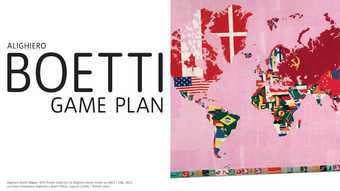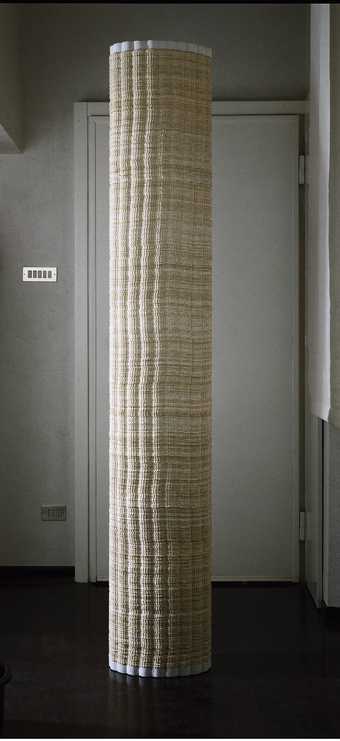Do we know what lies between right and left? This question might arise when an everyday mistake reminds us of the strange feeling, for example, of placing a left hand into a right-handed glove. We live in a space where the differences between left and right direct and occasionally disorientate our perceptions. In art historical literature on modern and contemporary art the hierarchy of verticals and horizontals and the orientation of an image have long been examined, but study of the distinction between left and right has, by and large, been neglected. However, in the art of the 1960s and 1970s there was a string of works that, literally, split classical pictorial unity along a central axis.
In a 16mm film by Alighiero e Boetti, made in 1970 for Gerry Schum’s television exhibition Identifications, broadcast on German TV, we initially see a close-up of the artist’s left and right hands simultaneously writing a date on a wall: “Giovedi ventiquattro settembre” (Thursday 24 September). The hands move away from each other as they write, and the further his arms spread apart, the further back the camera shot retreats, until his fully outstretched arms extend right across the screen. This synchrony between the movement of the figure and the camera lens zooming out is supported by a visual symmetry. In close-up, the clumsiness of the left hand is contrasted with the stability of the right. However, in the distance shot, the planar symmetry of the human being becomes apparent, the stem of the Y-shape formed by Boetti’s body marking the central axis of the image.
The idea of the double, the repeated and the mirror image appears in many of Boetti’s works. His symmetrically designed rugs made by Afghani weavers were intended to reflect a geographical and cultural exchange between East and West, and hence a form of abstract symmetry. A more active symmetry emerges from his project Postal Dossier 1969–70, for which he posted out letters into the world, and, as recipients were not at the given addresses, the letters were returned to sender. In 1968’s Twins we see a photograph of him and his double holding hands, a piece echoed in an embroidered work that included the words “Accanto a me ci sono” (“There I am next to me”).
We can see a structurally similar approach – where body and image relate to each other by virtue of their central axes – in Joan Jonas’s video Left Side Right Side 1972. Here, the artist effects a relatively simple task. Pointing to the left or right eye of an image of herself on a video screen, she declares: “This is my left (or right) eye.” At first, the monitor displays her face, then its inverted mirror image. The video and mirror images are then displayed next to one another and also become interchanged with each other. Disorientation arises from comparison of the two images, and it is hardly surprising that it becomes increasingly difficult for Jonas to carry out her task. At one point we see her hand coming into shot and hesitating briefly before making a decision. For a moment the artist, and us as viewers, are caught up in a transition where the lateral orientation of the space has not yet been established.
Jonas and Boetti endeavour to discover this undivided physical space by attempting to prosthetically connect the medium and the body. A video image challenges preestablished notions of bodily orientation, as it does not know what the difference is between left and right.
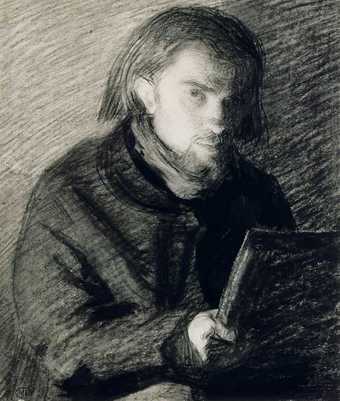
Henri Fantin-Latour
Self-Portrait c.1860
Pencil, charcoal and whitener
21.5 x 21 cm
Courtesy Musée du Louvre, Paris © RMN Michèle Bellot
Works in traditional media – drawing and painting - have a much closer relationship between body and image. The pieces of paper in the hands of a draughtsman are closely connected to the hands that create them. However, you can’t always tell which hand. Michael Fried has written specifically on a painting that illustrates the successful and problematic co-ordination of two unequal hands: Henri Fantin-Latour’s Self Portrait c.1860. This shows the artist at work, securing the paper with his right hand and presumably holding the charcoal in his hidden left one. However, we can tell from the conspicuous direction of the charcoal hatch-marks (upper-right to lower-left) that the picture was created by a right-handed artist. Fantin-Latour’s faithfulness in depicting his reversed image reflected in the mirror leads him to make an image in which he appears left-handed even as he creates with his right, drawing the viewer’s attention to the asymmetry of traditional picture making.
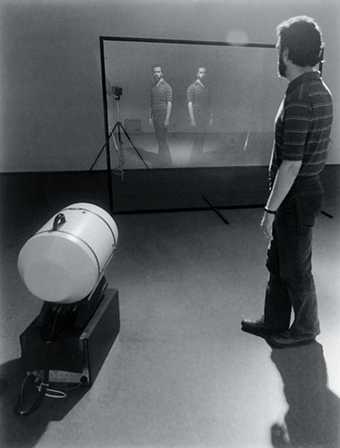
Peter Campus
Interface
Installation view at Kolnischer Kunstverein 1972
© Peter Campus
Peter Campus’s video installation Interface 1972 is another example of how new media opened up new artistic challenges and possibilities in dealing with the right/left distinction. A transparent glass plate stands in a darkened room. A video camera films the plate from one side and a projector relays this live signal back on to the other. The viewer is confronted with two real-time images of himself – the video image and his reflection – one the reverse of the other on either side of a symmetrical axis that runs vertically down the plate. As soon as the viewer crosses through this axis, from left to right or vice versa, mirror image and video image similarly cross over and exchange places. One can also embark on an initially entertaining but increasingly frustrating attempt to make the two images of oneself coincide, by posing as upright as possible on the symmetrical axis. It proves impossible, however, to conjure up that other dimension where there is as yet no difference between left and right. Moving from left to right, however slightly, results in the jerky alternation of the images, not a smooth transition through reversed worlds, but a cut that irrevocably splits the space and the images projected into it.
The technological configuration that Campus invites us into is not of the kind that moulds itself to our physical form. Instead, as in the work of Boetti or Jonas, it tempts us to go on playing with mirror, camera, projectors and images of ourselves.
In a period of technological shifts the old means of artistic expression are changing as well. Dieter Roth used drawing to explore another way of connecting the symmetrical axes of images and bodies. The different variants of his programmatic self-portrait - first formulated in 1966 – all show a head divided vertically into two half-skulls. The difference between left and right is literally deepened; it almost seems as though the spine has penetrated the skull and made a fold in it. In Mundunculum, Roth’s treatise on the power of symmetry, this topological folding of the human body is exactly described, as are the surprising connections arising from it. Other symmetries, beyond the bilateral symmetry of the skull, come to light – those between head and posterior, between phallus and breasts, positive and negative, individual and couple. The accentuation of the spinal column creates a fold that in turn gives rise to a more general symmetry and, hence, to a universally reversible body. Roth starts by doing two-handed drawing. He folds the paper down the middle, thereby giving it a body, and conjoins this, the paper body, with his own along a common plane of symmetry through putting pen to paper. The iconography of these two-handed drawings, of which he produced several hundred and reproduced huge numbers in print, consists exclusively of symmetrical hybrid bodies combining female and male, animals and things – an idea that becomes replicated when produced in many editions, or in book form.
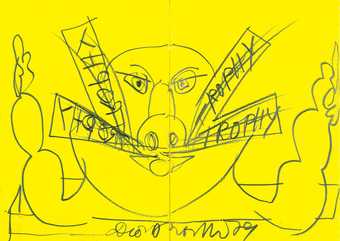
Dieter Roth
Two-Handed Speedy Drawing from the double-sided Trophies series 1979
Photo: www.zuckerartbooks.com © Hansjorg Mayer and Dieter Roth Estate
The works of all five artists cited here have their place in the history of self-portraiture. Lateral orientation and self-referentiality also point to each other in language. The meaning of terms such as “right” and “left”, like “I” and “you”, is only comprehensible from the point of view of the speaker. In contemporary self-portraits the relation between image and body changes when the eye of the camera makes no distinction between left and right. This uncoupling of image and body - already apparent in the self-portraits of Fantin-Latour – became particularly virulent when artists first started to utilise two technological innovations: video and cameras. The former brought the eye of the camera intimately close to the moving body; the latter created a second, non-reversed mirror image. So can we know what does actually lie between left and right?

